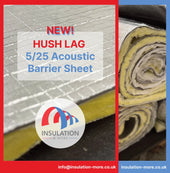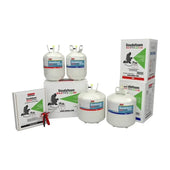Introduction to Fire Rated Insulation
The Role of Fire Rated Insulation in Building Safety
When we consider the safety of a building, fire rated insulation plays a pivotal role in ensuring the protection of life and property. It is designed not just to insulate, but also to resist the spread of fire, providing critical time for escape and preventing structural damage during a fire. The importance of this kind of insulation becomes apparent when we look at the statistics; according to the Fire Protection Association, the UK recorded over 200 fire-related deaths in residential properties alone in the year ending June 2021. By incorporating fire rated insulation, we contribute significantly to reducing these figures.
Fire rated insulation is integrated into the fabric of buildings, from residential homes to towering commercial complexes. Its primary function is to slow the spread of flames and smoke, which can be a determining factor in the survival of occupants and the building itself. Here's a quick look at why fire rated insulation is critical:
| Benefit | Description |
|---|---|
| Life Safety | Provides occupants more time to evacuate. |
| Property Protection | Limits damage to the building, reducing repair costs. |
| Fire-fighting Efficiency | Gives firefighters a better chance to control the fire. |
| Structural Integrity | Helps maintain the structural stability during a fire. |
| Insurance Compliance | Often required for compliance with insurance policies. |
Understanding Fire Rated Insulation: A Primer
At its core, fire rated insulation refers to a range of materials specifically engineered to withstand intense heat and resist burning, thereby reducing the risk of fire spread. These materials are gauged by how long they can maintain structural integrity and insulation properties during a fire. This duration can vary from 30 minutes to several hours, depending on the type of material and the thickness used.

The performance of fire rated insulation is measured against British and European standards, such as the BS EN 13501-1, which provides the reaction to fire classification. The ratings, from A1 to F, indicate how the material contributes to fire development and spread. For instance, materials classified as A1 are non-combustible and contribute no fire spread, whereas an F rating indicates that the material significantly contributes to fire spread.
Understanding the various aspects of fire rated insulation is critical for anyone involved in the construction industry. Whether you're an architect, a builder, or a facilities manager, recognizing the properties and applications of this kind of insulation ensures the safety of your project and its compliance with stringent fire safety standards.
Here's a brief breakdown of the concepts you'll encounter:
- Reaction to Fire: Measures how a product contributes to a fire.
- Resistance to Fire: Indicates how well a structure withstands fire, including its loadbearing capacity and integrity.
- Fire Propagation: Assesses the potential for a material to spread fire.
- Smoke Production: Quantifies the amount and opacity of smoke produced.
By integrating fire rated insulation into the design phase, we take a proactive step towards safeguarding against the devastating impact of fires. It's a testament to the adage that prevention is better than cure, especially when it comes to fire safety.
Understanding Fire Resistance
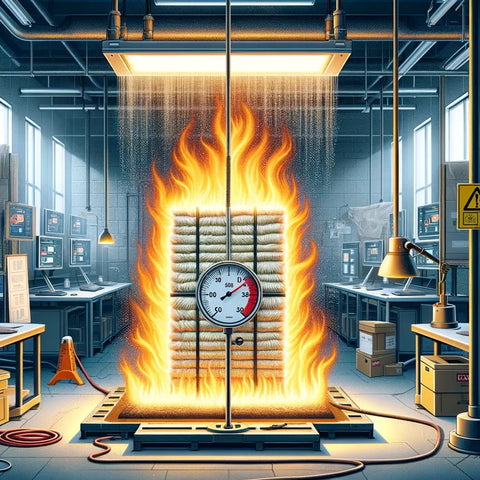
The Science of Fire Resistance in Insulation Materials
The science behind fire resistance in insulation materials is a sophisticated interplay of chemistry and physics. When exposed to fire, these materials are designed to undergo specific reactions that reduce the spread of flames and heat. The key is in the composition of the materials and the way they are treated to enhance their fire-resistant properties.
For example, some fire rated insulation materials may contain flame retardants that chemically react to fire, releasing substances that quell the flames. Others might form a char layer on the surface when exposed to heat, acting as a barrier that protects the core material from the fire.
Here's a table that illustrates some common reactions of fire rated insulation materials when exposed to high temperatures:
| Material Type | Reaction to Fire | Fire-Resistant Feature |
|---|---|---|
| Mineral Wool | Non-combustible | Forms a barrier; does not contribute to the spread of flames. |
| Fiberglass | Low flame-spread | Melts and fuses to form a barrier. |
| Foam Insulations | Varies; can be combustible | May contain flame retardants or build a char layer. |
| Phenolic Foam | Low smoke and flame-spread | Forms carbonaceous char that insulates and resists fire. |
Understanding these reactions helps us appreciate the engineering that goes into making insulation not just a thermal barrier, but also a life-saving feature of modern buildings.
Key Characteristics of Fire Rated Insulation
When we speak about key characteristics of fire rated insulation, we're looking at a combination of properties that make these materials stand out. Thermal stability, low flammability, and low smoke production are just the tip of the iceberg. A material’s ability to maintain its integrity without losing its insulative properties is what defines its fire resistance.
The following characteristics are paramount when evaluating the efficacy of fire rated insulation:
- Integrity: The ability to remain intact and not break, warp, or drop particles that could spread the fire.
- Insulation: The material's capacity to resist heat transfer and protect against temperature rise on the unexposed side.
- Non-combustibility: This indicates that the material does not support combustion.
- Minimal Toxic Smoke Emission: In a fire, the amount and toxicity of the smoke produced can be crucial to occupant safety.
- Flame Spread Rating: How quickly flames spread over the surface of the material.
| Characteristic | Importance |
|---|---|
| Integrity | Prevents structural collapse and maintains compartmentation. |
| Insulation | Protects against heat and preserves escape routes. |
| Non-combustibility | Reduces fire load and spread. |
| Toxic Smoke Emission | Ensures visibility and reduces inhalation risks. |
| Flame Spread Rating | Indicates containment capabilities. |
How Fire Rated Insulation Prevents the Spread of Flames
Fire rated insulation helps to prevent the spread of flames by acting as a physical barrier. It compartmentalizes the fire, slowing down the spread from one area to another, which is crucial in a fire incident. The materials used in fire rated insulation are selected based on their ability to withstand extreme heat without combusting or losing structural integrity.
One of the ways this is achieved is through the creation of 'firestops'. These are sections of fire resistant materials placed within the building's structure to prevent the passage of fire through openings created by penetrations, such as pipes or cables. In essence, firestops are a form of passive fire protection — a critical element in modern building design.
In addition to compartmentalization, fire rated insulation also contributes to the overall thermal performance of a building, ensuring that the interior temperatures remain stable, even when a part of the building is exposed to fire. This dual role of thermal insulation and fire resistance makes for a safer and more energy-efficient building envelope.
The table below outlines how fire rated insulation contributes to the prevention of flame spread:
| Prevention Method | Description |
|---|---|
| Compartmentalization | Limits fire to its area of origin. |
| Firestops | Blocks pathways for fire and smoke. |
| Thermal Performance | Maintains temperatures, preserving structural integrity. |
Incorporating fire rated insulation into the building design is a strategic move that not only adheres to safety regulations but also provides peace of mind to the occupants and owners. It's an investment in safety that we cannot afford to overlook.
Fire Rating Standards and Compliance
Overview of Fire Rating Standards: Global Perspective
Navigating the complex world of fire rating standards is essential for ensuring that insulation materials meet the stringent requirements for fire safety. Globally, there are a variety of standards in place, each designed to rigorously test and classify materials based on their fire resistance properties. In the UK, for instance, the British Standard BS 476 and the European classification system BS EN 13501-1 are among the key benchmarks for fire safety performance.
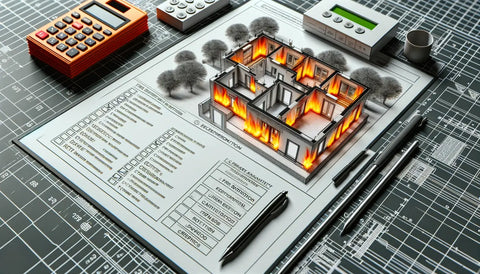
Standards such as these provide a consistent framework to measure how materials will behave in a fire, and they inform the selection process for materials to be used in construction. Below is a brief overview of global fire rating standards:
| Standard | Region | Key Aspects |
|---|---|---|
| BS EN 13501-1 | Europe/UK | Classifies reaction to fire with ratings from A1 to F |
| BS 476 | UK | Includes tests for fire propagation and surface spread of flame |
| ASTM E119 | USA | Assesses the fire resistance of building elements |
| ISO 1182 | International | Determines non-combustibility of building materials |
It is crucial for professionals in the construction and building services industries to be well-versed in these standards to ensure compliance and safety of their projects.
Building Codes and Fire Rated Insulation Compliance
Compliance with building codes is non-negotiable when it comes to fire rated insulation. These codes, which incorporate references to fire rating standards, dictate the minimum requirements for the safe design and construction of buildings.
In the UK, Approved Document B of the Building Regulations governs fire safety and outlines the necessary fire protection measures that must be incorporated into building designs. These regulations emphasize the use of materials that meet the required fire performance criteria, ensuring that the insulation installed provides adequate protection against the spread of fire.
Here's a summary of how building codes and compliance intersect:
| Building Code Aspect | Importance |
|---|---|
| Material Selection | Ensures the use of appropriate, fire-rated insulation materials. |
| Installation | Mandates proper installation to maintain the fire resistance integrity. |
| Certification | Requires materials and installation to be certified for compliance. |
| Inspection | Involves regular checks to validate ongoing compliance with fire safety standards. |
The Importance of Fire Rating in Insulation Selection
Choosing the right fire rated insulation for a construction project is a decision that cannot be taken lightly. The fire rating of an insulation product directly impacts the safety of a building's occupants and the building's ability to withstand a fire incident.
When selecting insulation, it's not only about the thermal performance, but also how well it can contain a fire, resist the spread of flames, and limit the production of smoke. These factors are all influenced by the material's fire rating, which is why it is paramount in the selection process.
| Consideration | Why It Matters |
|---|---|
| Fire Rating | Determines the material's suitability for specific applications. |
| Compliance | Ensures the material meets local fire safety regulations. |
| Safety | Reduces the risk of fire-related casualties and damage. |
Ultimately, fire rated insulation is about creating a safe environment. As we contribute to building projects, our due diligence in selecting the correct insulation with the appropriate fire rating is our commitment to upholding the highest standards of safety and compliance. It's an investment in the safety and integrity of our built environment that yields immeasurable returns.
Types of Fire Rated Insulation
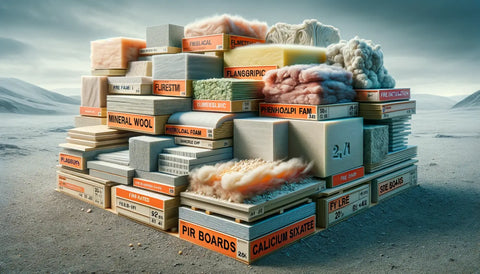
Overview of Different Fire Rated Insulation Materials
The market offers a diverse selection of fire rated insulation materials, each with its unique properties and fire resistance capabilities. The choice of material often hinges on factors such as required fire rating, budget, and specific application needs. Below, we provide an overview of some of the most commonly used fire rated insulation materials:
| Material | Fire Rating | Typical Use Cases |
|---|---|---|
| Mineral Wool Insulation | A1 | Walls, ceilings, floors |
| Fiberglass Insulation | A1 – B | Attics, walls, ductwork |
| Phenolic Foam | B – C | Ductwork, ceilings, floors |
| PIR (Polyisocyanurate) | B – C | Roofing, walls, floors |
| Calcium Silicate | A1 | Industrial, high-temperature |
Each type of insulation offers varying degrees of fire resistance, from non-combustible to lower classifications that still provide significant protection against fire.
Comparing Fire Rated Insulation: Pros and Cons
When selecting fire rated insulation, weighing the advantages and disadvantages of each material type is vital to making an informed decision. Here we compare the pros and cons of different fire rated insulation materials:
Mineral Wool Insulation
Pros:
- Non-combustible and does not contribute to fire spread.
- Provides excellent acoustic insulation.
- Resists mould and moisture.
Cons:
- Can be more expensive than some synthetic options.
- Requires protective gear during installation due to irritant fibres.
Fiberglass Insulation
Pros:
- Widely available and cost-effective.
- Good thermal resistance.
- Lightweight and easy to handle.
Cons:
- Lower fire resistance compared to mineral wool.
- Protective gear needed during installation due to glass particles.
Phenolic Foam
Pros:
- Low smoke emission and flame spread.
- High thermal efficiency.
- Resistant to moisture and chemical exposure.
Cons:
- More expensive than fiberglass.
- Can be more brittle and less flexible.
PIR (Polyisocyanurate)
Pros:
- High thermal performance with a thinner profile.
- Resistant to moisture and mould.
Cons:
- Can release toxic gases when exposed to fire.
- Higher cost than some other synthetic insulations.
Calcium Silicate
Pros:
- Excellent for high-temperature applications.
- High compressive strength.
Cons:
- More rigid and difficult to install in some scenarios.
- Can be more costly due to its specialised application.
Specialty Insulation: High-Temperature Applications
For applications that demand insulation performance at extreme temperatures, specialty insulation materials are the go-to solution. These materials are engineered to maintain structural integrity and insulation properties even under intense heat conditions found in industrial environments.
Such high-temperature applications typically require materials like calcium silicate or ceramic fiber insulation, which can withstand temperatures exceeding 1000°C. These products are essential for ensuring safety and efficiency in industries like petrochemical, power generation, and metal processing.
Here's a comparison of specialty insulation materials for high-temperature applications:
| Material | Max Temp (°C) | Application |
|---|---|---|
| Calcium Silicate | ~1000 | Industrial piping, furnaces |
| Ceramic Fiber | ~1260 | Kilns, boilers, high-temperature ductwork |
The choice of fire rated insulation must be tailored to the specific requirements of the project, taking into consideration the fire safety standards, desired thermal performance, and the environmental conditions of the application. With the right selection, buildings can be made safer and more energy-efficient, ultimately protecting lives and investments.
Installation and Application
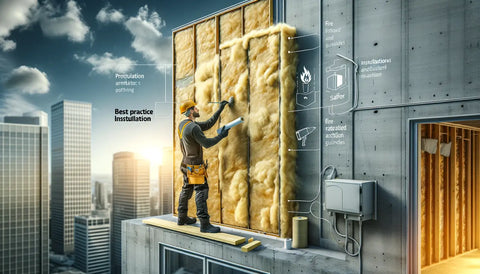
Installation Best Practices for Fire Rated Insulation
Proper installation of fire rated insulation is as critical as the selection of the insulation material itself. Incorrect installation can compromise the material's fire protective properties and overall effectiveness. Here are some best practices to ensure optimal performance:
- Follow Manufacturer's Guidelines: Each type of insulation comes with specific instructions from the manufacturer, tailored to maximize its fire resistant capabilities.
- Ensure Complete Coverage: Avoid gaps, as these can undermine the fire safety of the entire system.
- Seal Penetrations Properly: Use appropriate fire stopping materials for any openings to maintain integrity.
- Wear Protective Equipment: Installers should wear the correct protective gear, as some insulation materials can be hazardous to handle.
| Best Practice | Purpose |
|---|---|
| Adhering to Guidelines | Guarantees the insulation's designed fire resistance is met. |
| Complete Coverage | Eliminates weak points where fire can penetrate. |
| Sealing Penetrations | Preserves the fire barrier's continuity. |
| Safety Equipment | Protects the installers from health hazards. |
Residential Applications of Fire Rated Insulation
In residential settings, fire rated insulation is often used in areas susceptible to fire risks, such as kitchens, fireplaces, and around heating systems. Its application serves to protect the structure of the home and provide the occupants with precious time to evacuate in the event of a fire. It's also used in loft conversions and between floors to prevent the spread of fire between levels.
Residential applications include:
| Area | Insulation Type | Benefit |
|---|---|---|
| Attic/Loft | Mineral Wool | Prevents fire spread from the roof. |
| Basement | Foam Board Insulation | Resists combustion and moisture. |
| Internal Walls | Fiberglass | Adds a layer of fire resistance. |
Commercial and Industrial Use of Fire Rated Insulation
In commercial and industrial environments, fire rated insulation is crucial due to the larger scale of the premises and the potential presence of flammable materials. It is used extensively in office buildings, factories, and warehouses to compartmentalize spaces, protect structural elements, and cover pipes and ductwork. This not only safeguards the building but also ensures business continuity by minimizing potential fire damage.
Commercial and industrial applications often utilize:
| Area | Insulation Type | Benefit |
|---|---|---|
| HVAC Systems | Duct Insulation | Controls fire spread through air systems. |
| Industrial Piping | Rockwool Insulation | Withstands high temperatures and prevents fire spread. |
| Structural Steel | Intumescent Coatings | Expands to protect metal from heat. |
Case Studies: Real-World Applications and Benefits
Case studies provide a concrete look at the benefits of fire rated insulation in practice. For instance, the use of Rockwool insulation in a large-scale residential development in London helped the structure meet stringent fire safety codes while enhancing its thermal and acoustic performance. Similarly, a retrofit project for an office building utilized PIR insulation for its combination of thermal efficiency and improved fire safety ratings.
| Project | Insulation Type | Outcome |
|---|---|---|
| Residential Tower | Rockwool | Met fire safety codes and improved energy efficiency. |
| Office Retrofit | PIR | Enhanced fire safety and thermal performance. |
These examples underscore the importance of integrating fire rated insulation into the design and renovation of buildings to ensure they meet the required safety standards and provide a safer environment for occupants. Whether for residential, commercial, or industrial applications, the proper use of fire rated insulation is an essential component of modern construction that plays a vital role in protecting lives and property.
Safety, Health, and Environmental Considerations

Health and Safety Guidelines for Handling Fire Rated Insulation
Handling fire rated insulation requires adherence to strict health and safety guidelines to protect those involved in its installation and maintenance. It's important to understand that some insulation materials can pose health risks due to the release of fibres or dust during handling.
| Health and Safety Guideline | Purpose |
|---|---|
| Use of Protective Equipment | To protect skin and respiratory systems from irritant fibres. |
| Adequate Ventilation | To reduce the inhalation of any airborne particles. |
| Safe Cutting Practices | To minimize the release of fibres and dust into the air. |
| Proper Disposal | To ensure that waste materials are handled responsibly. |
Protective equipment often includes gloves, long sleeves, protective eyewear, and respirators or masks, particularly when working with materials like mineral wool or fiberglass. It's essential for workers to be trained on how to safely handle and install these products to mitigate any potential risks.
Environmental Impact and Sustainability of Fire Rated Insulation
As we become more conscious of our environmental footprint, we also reflect on the sustainability of the materials we use in construction. Fire rated insulation is no exception. Fortunately, many fire rated insulation products are made from recyclable materials, such as glass or rock, which have a lower environmental impact. Others are made with bio-based materials that further reduce the carbon footprint.
| Insulation Material | Environmental Benefit |
|---|---|
| Recycled Glass Wool | Utilizes recycled glass, reducing landfill waste. |
| Natural Mineral Wool | Often made from natural basalt rock, an abundant resource. |
| Bio-based Sprays | Made from renewable materials, contributing to sustainability. |
Moreover, by improving the energy efficiency of buildings, insulation indirectly reduces greenhouse gas emissions associated with heating and cooling, making it an integral part of sustainable building practices.
Innovations in Eco-Friendly Fire Rated Insulation
The insulation industry continues to innovate, developing new products that offer both fire resistance and environmental benefits. These innovations often focus on reducing the toxicity of flame retardants, increasing recyclability, and using sustainable raw materials.
Some notable advancements include:
- Low GWP (Global Warming Potential) Insulants: These materials, such as certain foam insulations, aim to minimize environmental impact.
- Natural Fire Retardants: Research into non-toxic, naturally derived fire retardants is ongoing, with promising results for future applications.
- Recycled Content: Products that incorporate a high percentage of recycled content are becoming more prevalent, which helps to reduce waste.
Key Takeaways
When considering fire rated insulation, it is imperative to balance safety, health concerns, and environmental impact. We must ensure that our choices contribute to a safer and more sustainable future. By adhering to health and safety guidelines, selecting sustainable materials, and embracing innovative solutions, we foster a responsible approach to fire safety in the construction industry.
| Takeaway | Significance |
|---|---|
| Safety and Health Compliance | Protects installers and end-users from potential hazards. |
| Environmental Responsibility | Encourages the use of sustainable materials. |
| Embracing Innovation | Supports the advancement of eco-friendly fire safety solutions. |
Conclusion
In conclusion, fire rated insulation is an essential component of modern construction that offers critical protection against the dangers of fire. By understanding the various types of materials, adhering to fire rating standards, and implementing best installation practices, we can significantly improve the safety of our buildings. Moreover, taking into account the health and environmental considerations ensures that our approach to fire safety aligns with the wellbeing of individuals and the planet. Through continuous innovation and a commitment to excellence, we can achieve the highest standards of fire protection and sustainability in the built environment.
Frequently Asked Questions About Fire Rated Insulation
1. What determines the fire rating of an insulation material?
The fire rating of insulation is determined by its ability to withstand and slow the spread of fire. This is tested through a series of standardised fire tests that measure characteristics such as flame spread, smoke development, combustibility, and the material's ability to maintain structural integrity during exposure to high temperatures.
2. Is fire rated insulation also soundproof?
Many fire rated insulation materials, such as mineral wool, inherently have soundproofing qualities due to their dense structure. However, the primary function of these materials is to provide fire resistance, and while they may contribute to sound dampening, they may not be as effective as dedicated acoustic insulation materials.
3. Can fire rated insulation be painted or covered with other materials?
Yes, fire rated insulation can often be painted or covered with materials like drywall or cladding, but it's important to use products that also meet fire resistance requirements to not compromise the overall fire safety of the structure.
4. How often should fire rated insulation be inspected or replaced?
Fire rated insulation should be inspected regularly as part of a building's fire safety maintenance schedule. The frequency of these inspections can vary depending on the building codes and the conditions of use. Replacement is necessary if the insulation has been damaged or has deteriorated, affecting its fire resistance properties.
5. Can fire rated insulation contain asbestos?
Modern fire rated insulation materials do not contain asbestos. Historically, asbestos was used for its fire resistant properties, but due to health risks, it has been banned in many countries. All current fire rated insulation materials are asbestos-free and comply with health and safety regulations.
6. Are there any lightweight fire rated insulation options available?
Yes, there are lightweight fire rated insulation options such as certain foam boards and thin-profile insulating materials like PIR (Polyisocyanurate). These products offer fire resistance while being easier to handle and install due to their lower density.
7. Does fire rated insulation contribute to indoor air quality?
Fire rated insulation can contribute to indoor air quality by reducing the potential for smoke and toxic gas production during a fire. Some materials are also designed to be low in volatile organic compounds (VOCs), which further enhances indoor air quality in everyday conditions.
8. What is the best fire rated insulation for use in high-moisture areas?
For high-moisture areas, closed-cell foam insulation materials such as extruded polystyrene (XPS) or spray foam with fire retardant properties are often recommended, as they resist water absorption and can maintain their fire resistance even in damp conditions.
9. Are there fire rated insulation options made from renewable resources?
Yes, there are fire rated insulation products that use renewable resources, such as cellulose insulation, which is made from recycled paper treated with fire retardant chemicals. Additionally, some bio-based spray foams incorporate renewable materials and offer fire resistant qualities.
10. How does fire rated insulation affect the energy efficiency of a building?
Fire rated insulation materials are designed to provide thermal resistance, which helps to maintain a building's temperature. This thermal efficiency reduces the need for heating and cooling, thereby contributing to energy savings and creating a more sustainable building environment.






